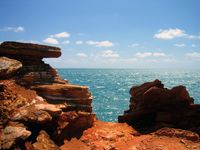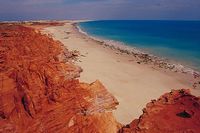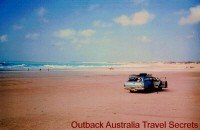Broome Australia
The Southern Gateway to the Kimberley Region
No matter where you look, the Kimberley town Broome and its surrounds seem like a picture postcard come to life.
I think it is impossible to take boring photos here...
The intense reds of the Outback pindan and sandstone formations contrast with the turquoise and azure waters of the Indian Ocean in a striking way.
 Add seemingly endless white beaches, palm fringed ocean hideaways, multicultural and exotic flair, ancient boab trees, Outback wilderness...
Add seemingly endless white beaches, palm fringed ocean hideaways, multicultural and exotic flair, ancient boab trees, Outback wilderness...
It's easy to see why tourists and photographers alike are drawn to Broome in Australia.
Here you can have it all:
Relaxing on the beaches, sunset lugger cruises, extended boat charters, fishing charters, crabbing, scenic flights, four wheel drive tours, cultural tours, historical tours, bird watching, bush walks, camel treks, and, and, and...
Interested?
On this and the following pages you can read all about this picturesque area, its history, how to get there, the Broome attractions, where to find Broome accommodation, and even how to get away from tourists if that's what you like.
(And if you heard negative things about Broome you might be interestd in this article: Broome, Western Australia - Overrated Holiday Destination?)
The History of Broome Australia
William Dampier was the first European to visit these shores in 1688, his ship was the H.M.S. Roebuck. The Dampier Peninsula, Roebuck Bay and of course the famous Roebuck Hotel on Dampier Terrace are all named after this first visit.
An unsuccessful attempt to develop the area to graze sheep started in the 1860s and was soon abandoned. (Cattle arrived around 1885, when the McDonalds and the Duracks established the first cattle stations across the Kimberley.)
All in all it took nearly a full 200 years until Broome, Australia saw its official birth in 1883. It was decreed to be a township by Sir Frederick Napier Broome, then Governor of Western Australia.
Ironically the Governor didn't want to be associated with the new "town", which at that time wasn't much more than a few struggling camps...
Pearl oysters had been discovered in Roebuck Bay in 1861. The Pinctada maxima turned out to be the largest pearl shell in the world, and within only three years the industry supplied 75% of the world's Mother of Pearl!
When the route of the submarine telegraph cable was changed to run through Broome rather than Darwin in 1890 things finally started to happen.
The story of the Cable House, the office for the telegraphists, is an interesting one. Apparently the building was meant for Kimberley in South Africa. Instead it arrived on the western edge of the Australian Kimberley, which at the time didn't have a jetty. Chinese labourers had to cart eveything across the mudflats... ah well. It was built anyway.
It still stands today as the Court House on the corner of Hamersley and Frederick Street.
The location of Broome and the port helped the town and pearling industry to grow. By 1900 the town supported a whole fleet of pearl luggers (the number of boats peaked at 403 in 1913) and over 3000 pearl divers. Most of the pearl divers arrived from different parts of Asia. Malays, Chinese, Japanese, Filipinos and otheres mixed with Europeans and Aborigines... The pearl divers made Broome the fascinating multicultural town that it is today.
While the pearling masters and their industry prospered the occupation proved fatal for many of the pearl divers. The "bends", drowning, sharks and cyclones ended many dreams of a comfortable life...
A deep water jetty was built in 1897, and the customs house that came with it is a museum today. A police station, a hospital and a gaol followed...
After WWI the economy collapsed. The depression affected the pearling industry like any other industry. In WWII the town and its port were attacked by the Japanese on the 3rd of March 1942. Three of the boats that were destroyed by Japanese bombs can still be seen in the bay at very low tide today.
And then in the 1950s a crucial invention hit the market: Yep, the plastic button.
The plastic button sealed the fate of the Mother of Pearl industry, but not the fate of Broome. The industry adapted and in fact was revived in the late 1950s by introducing cultured pearls. 20 years later the town produced up to 70% of the world's large cultured pearls. It continues to be one of the world's major suppliers for quality pearls today.
The 1980s saw a new industry emerge: tourism discovered the Kimberley and is growing fast! Today the town has a population of nearly 14,000, is easy to reach (see below) and offers anything in terms of accommodation, dining, shopping and activities that a visitor could ask for. See below or the links at the top for more on that, too.
How to get to Broome in Australia
 Broome is situated on the far north western coast of Western Australia. Getting there was a major adventure in the past. It was still an adventure when I arrived in the Kimberley many years ago.
Broome is situated on the far north western coast of Western Australia. Getting there was a major adventure in the past. It was still an adventure when I arrived in the Kimberley many years ago.
Long stretches of the highway from Port Hedland and across the Kimberley to Darwin were unsealed or single lane.
The drive took days and the traveller was at the mercy of the elements. The wet season changed our travel plans for us more than once... Luckily for tourists these days are a thing of the past...
Today Broome is very well connected to the rest of the world. The small town even boasts an international airport.
At this stage Broome airport only services international charters and private flights, but direct international flights with regular schedules are soon to come.
Qantas, Airnorth, Virgin Blue and Sky West provide regular flights to and from other parts of Australia.
Qantas has partnered with many other international airlines. To book the domestic flights together with your international flight as a package is usually the most economic way, so Qantas is often the domestic carrier of choice for international visitors.
Go here to check the current time table for Qantas flights from anywhere in Australia.
Driving to Broome is easier than it used to be, but it still involves great distances and some preparation, especially if you want to drive all the way from Perth or Darwin.

The over 600 km drive from Port Hedland in the south will take you past 80 Mile Beach (the name says it all...) and Port Smith. Beautiful!
Services and accommodation are available on the way.
On the other side of Broome is Kununurra.
This next major Kimberley town lies 1040km to the east along the excellent Great Northern Highway. This most scenic highway in all of Australia will also take you through some smaller Kimberley settlements and to several of the national parks in the Kimberley.
The other route to/from Kununurra leads right through the heart of the Kimberley along the rugged unsealed Gibb River Road. This trip is for the more adventurous and requires a four wheel drive vehicle. It is well worth the expense of hiring a vehicle as you will see some of the most beautiful and remote places on this planet...
Those without their own transport can use the new 4x4 bus service along the Gibb River Road. It accesses many locations on the way, and with the multi-stop ticket you can get on and off as you please and stay in the wilderness as long as you like. A great way to go for overseas travellers. I wish it had been available when I was still backpacking around...
Next page: Broome Attractions, What to See and Do
Find more information about the Kimberly Australia
Return to Outback Australia Tavel Guide home page






